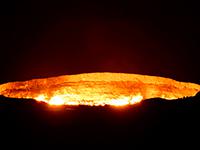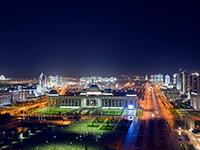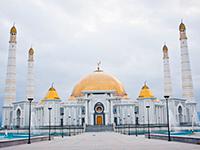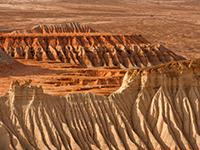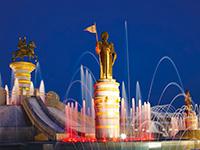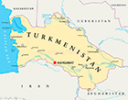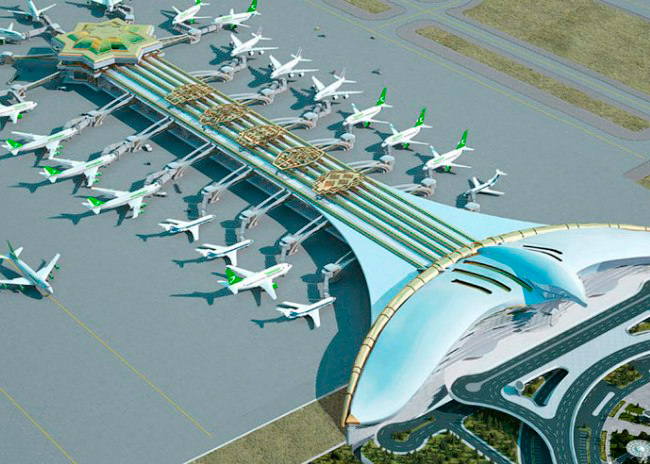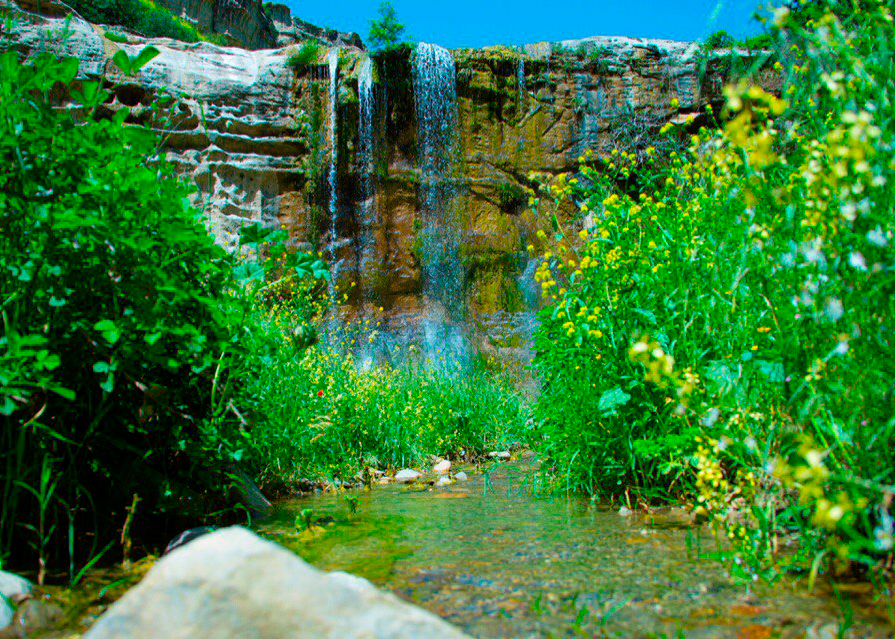-
History
Evidence of human life on the territory of present-day Turkmenistan started in the Paleolithic Era. Rock inscriptions can be seen in Jebel in the Krasnovodsk Peninsula, and various finds can be observed in the National Museum in Ashgabat.
>>> Read more -
Cooking
Turkmen cuisine is varied, and includes both meat dishes and soups, and as well as plenty of fruits and vegetables. Bread is a must for every meal.>>> Read more -
Nature
A boring landscape? In actual fact Turkmenistan holds some of the most fascinating diversity of landscapes, from moving sand dunes and limestone cliffs, to lush river valleys and mountains created in the Jurassic period>>> Read more -
Traditions
Turkmen are a Turkic-speaking people of nomadic origin (similar to the Kazakhs steppe nomads and the Kyrgyz mountain nomads, and differing from the Persian-speaking Tajiks, or the Turkic-speaking settled Uzbeks).>>> Read more -
Arts and crafts
Traditional Turkmen women’s garments are real pieces of art. Dresses, overcoats and scarves are made form fine material, woven on simple horizontal looms, and decorated with intricate embroidery, unique in the Central Asian region.>>> Read more -
Ahalteke horses
Experts say that nowhere in the world but in Turkmenistan nature and man’s efforts have succeeded in creating such a graceful, exceptional, tireless, sturdy, noble horse as the Akhal Teke.>>> Read more -
Health
Sun stroke and dehydration are the two main risks to your health in the Turkmen sunshine. A head cover and drinking sufficient fluids (water, juice, soda, tea, soup, etc) will largely protect you against these risks.>>> Read more -
Climate
The climate is sharply continental with little rainfall during summer. Summer is dry. Precipitation is low - about 240 mm a year. With over 250 days of sunshine, Turkmenistan is often called the country of eternal sunshine.>>> Read more -
What currency to bring
The national currency is the Turkmen manat. One manat is divided into100 tenge.>>> Read more -
Communication
International telephone calls can be made from most hotels, although prices are very high in comparison to public Call Centers.>>> Read more -
Electricity
In Turkmenistan the standard voltage is 220 V. The standard frequency is 50 Hz. The power sockets that are used are of type C / F. Your need for an adapter depends on the voltage, frequency and power plugs in the country you live in.>>> Read more -
Traveling within Turkmenistan
Turkmenistan airlines operate regular air connections from Ashgabat to five other major Turkmenistan cities (Turkmenabat, Mary, Dashoguz, Turkmenbashi, and Balkanabad).>>> Read more -
Before you go
Bring cash USD bank notes (do not rely on EURO, credit cards or travelers cheques for your local expenses in Turkmenistan; visa, migration tax and vehicle transit costs can be paid in cash USD exclusively)>>> Read more -
How to get to Turkmenistan
The international airport of Ashgabat is one of Turkmenistan’s major gateways.>>> Read more -
When to Go
Turkmenistan’s climate is extremely continental with hot, dry summers. Midsummer temperature can reach 45 °C. However, such temperatures are quite bearable because of the very low humidity.>>> Read more -
Turkmenistan Visa
In general all foreign nationals are required to have a visa to enter the Republic of Turkmenistan. Tourist visa is issued by the Immigration Service of the Republic of Turkmenistan
>>> Read more
-
 Independence ParkThe Independence Park hosts the Ruhnama Book Monument, the Monument dedicated to the fifth year of independence and the Monument dedicated to the tenth year of independence.
Independence ParkThe Independence Park hosts the Ruhnama Book Monument, the Monument dedicated to the fifth year of independence and the Monument dedicated to the tenth year of independence. -
 Ahalteke MonumentIn the center of Ashgabat, with a view onto the central square, we can see a monument that consists of 10 Ahalteke horses, the pride of Turkmenistan.
Ahalteke MonumentIn the center of Ashgabat, with a view onto the central square, we can see a monument that consists of 10 Ahalteke horses, the pride of Turkmenistan. -
 Ertogrul Ghazi MosqueThe mosque, inaugurated in 1998 and constructed by a Turkish construction company, is named after Ertogrul Ghazi, the father of Osman I, the founder of the Ottoman Empire.
Ertogrul Ghazi MosqueThe mosque, inaugurated in 1998 and constructed by a Turkish construction company, is named after Ertogrul Ghazi, the father of Osman I, the founder of the Ottoman Empire. -
 Neutrality ArchOriginally constructed next to the Central Square in the old city center, it was the landmark of Ashgabat, until in late 2011 re-opened at its new location at the southern edges of the city.
Neutrality ArchOriginally constructed next to the Central Square in the old city center, it was the landmark of Ashgabat, until in late 2011 re-opened at its new location at the southern edges of the city. -
 Oguzhan Statue and Fountain ComplexImmediately upon your arrival in Ashgabat you will be welcomed by a vast statue of the mythical founding father of the Turkmen nation, Oguzkhan.
Oguzhan Statue and Fountain ComplexImmediately upon your arrival in Ashgabat you will be welcomed by a vast statue of the mythical founding father of the Turkmen nation, Oguzkhan. -
 National MuseumOpened in 1998, the museum's 9 history halls houses the Turkmenistan’s major collection of artifacts discovered at various excavation sites in Turkmenistan.
National MuseumOpened in 1998, the museum's 9 history halls houses the Turkmenistan’s major collection of artifacts discovered at various excavation sites in Turkmenistan. -
 Carpet MuseumOpened originally in 1994 and re-opened in its new home in 2008, the museum offers an impressive collection of antique and contemporary Turkmen carpets.
Carpet MuseumOpened originally in 1994 and re-opened in its new home in 2008, the museum offers an impressive collection of antique and contemporary Turkmen carpets. -
 Weekend BazaarThe original bazaar was called Tolkuchka Bazaar (or Push Market) and was the biggest bazaar in Central Asia. Now it has been slightly relocated and renamed Altyn Asyr Gundogar Bazaar.
Weekend BazaarThe original bazaar was called Tolkuchka Bazaar (or Push Market) and was the biggest bazaar in Central Asia. Now it has been slightly relocated and renamed Altyn Asyr Gundogar Bazaar. -
 Ferris WheelSince 2012, Ashgabat hosts the world’s largest Ferris wheel in an enclosed architectural design. It measures 47,60 meters in height, and has a diameter of 57 meters.
Ferris WheelSince 2012, Ashgabat hosts the world’s largest Ferris wheel in an enclosed architectural design. It measures 47,60 meters in height, and has a diameter of 57 meters. -
 Stairs of HealthA 33-km long concrete stairway across the foothills of the Kopetdag Mountains, constructed on the orders of the first president of Turkmenistan in the early nineties.
Stairs of HealthA 33-km long concrete stairway across the foothills of the Kopetdag Mountains, constructed on the orders of the first president of Turkmenistan in the early nineties. -
 National HippodromeEvery Sunday in spring and autumn horse races take place at the National Hippodrome, located at the eastern outskirts of Ashgabat.
National HippodromeEvery Sunday in spring and autumn horse races take place at the National Hippodrome, located at the eastern outskirts of Ashgabat. -
 Ahalteke horseA variety of Ahalteke private horse farms and stables can be visited for those that want to observe these gorgeous horses from a safe distance.
Ahalteke horseA variety of Ahalteke private horse farms and stables can be visited for those that want to observe these gorgeous horses from a safe distance.
-
 AnauJust outside Ashgabat to the east, Anau is the site of an urban settlement that existed since the Bronze Ages, but flourished particularly under Parthian and Timurid rule.
AnauJust outside Ashgabat to the east, Anau is the site of an urban settlement that existed since the Bronze Ages, but flourished particularly under Parthian and Timurid rule. -
 AbiverdAbiverd is an archeological site showing settlements that existed since II c. BC, but particularly thriving as one of the principal Silk Road cities of Northern Khorasan.
AbiverdAbiverd is an archeological site showing settlements that existed since II c. BC, but particularly thriving as one of the principal Silk Road cities of Northern Khorasan. -
 Meane Baba MausoleumMehne was a medieval urban Silk Road town that connected Merw with Serakhs. At the outskirts of the town the mausoleum of Abu Said (locally referred to as Meane Baba) is located.
Meane Baba MausoleumMehne was a medieval urban Silk Road town that connected Merw with Serakhs. At the outskirts of the town the mausoleum of Abu Said (locally referred to as Meane Baba) is located. -
 Ulug DepeThe archeological site of Ulug Depe is unique in that it represents proof of the longest chronological sequence of human habitation ever found on the territory of Central Asia.
Ulug DepeThe archeological site of Ulug Depe is unique in that it represents proof of the longest chronological sequence of human habitation ever found on the territory of Central Asia. -
 Altyn DepeToday at Altyn Depe archeological site a 22m meter high mount, covering a 46ha territory, indicates the presence of a settlement from the Bronze Age (3000-1600 BCE).
Altyn DepeToday at Altyn Depe archeological site a 22m meter high mount, covering a 46ha territory, indicates the presence of a settlement from the Bronze Age (3000-1600 BCE). -
 Namazga DepeIn the same area lies Namazga Depe, where excavations from various time periods functions as reference for the chronology of other Bronze Age sites in Turkmenistan.
Namazga DepeIn the same area lies Namazga Depe, where excavations from various time periods functions as reference for the chronology of other Bronze Age sites in Turkmenistan. -
 Nodir Shah FortressThe remains of a large fortress, built on orders of the 18th century Persian governor Nadir Shah, is located against the backdrop of the Kopetdag Mountains.
Nodir Shah FortressThe remains of a large fortress, built on orders of the 18th century Persian governor Nadir Shah, is located against the backdrop of the Kopetdag Mountains. -
 Nissa Historical ParkLocated on a natural high platform at the foothills of the Kopetdag mountains, Nissa owes its importance to the early Parthian rulers who took over control of the area in III c. BC.
Nissa Historical ParkLocated on a natural high platform at the foothills of the Kopetdag mountains, Nissa owes its importance to the early Parthian rulers who took over control of the area in III c. BC. -
 KipchakThe Ruhy Mosque (literally: spiritual mosque) at Kipchak was built between 2002 and 2004, and is one of the five largest mosques in the world (capacity of 20,000 people).
KipchakThe Ruhy Mosque (literally: spiritual mosque) at Kipchak was built between 2002 and 2004, and is one of the five largest mosques in the world (capacity of 20,000 people). -
 Geok Depe Mosque and FortressGeok Depe (‘Green Hill’) hosts the remains of a 19th-century fortified settlement, where in 1881 a decisive battle between the forces of the Russian tsar and Turkmens of the Teke tribe took place.
Geok Depe Mosque and FortressGeok Depe (‘Green Hill’) hosts the remains of a 19th-century fortified settlement, where in 1881 a decisive battle between the forces of the Russian tsar and Turkmens of the Teke tribe took place. -
 Kowata underground lake in BahardenKowata (literally: Father of Caves) is one out of a dozen karst caves in Turkmenistan, created as a result of carbonate accumulation millions of years ago.
Kowata underground lake in BahardenKowata (literally: Father of Caves) is one out of a dozen karst caves in Turkmenistan, created as a result of carbonate accumulation millions of years ago. -
 Kopetdag Mountains and the lunar landscapesThe mountains form a natural border with Iran, hosts some unique protected flora, birds and mammals, and some bizarre lunar-like landscapes. The Sumbar river area runs through the range.
Kopetdag Mountains and the lunar landscapesThe mountains form a natural border with Iran, hosts some unique protected flora, birds and mammals, and some bizarre lunar-like landscapes. The Sumbar river area runs through the range. -
 Nohur
NohurNohur is home to a small community that lives in the high valleys of the Kopetdag Mountains. Nohur local culture has been preserved due to its isolation from mainland Turkmenistan.
-
 Karakala
KarakalaKarakala is a small and pleasantly tree-lined mountain town in the heart of the Kopetdag Mountains, from where both the fertile river valleys as well as the lunar-like landscapes can be visited.
-
 Karakum Desert
Karakum DesertThe Karakum covers nearly 80% of Turkmenistan’s territory and is bordered by the Ustyurt Plateau, the Amu Darya and Murghab rivers, and the old Uzboy River and salt lakes near the Caspian Sea.
-
 Erbent and Bokurdok
Erbent and BokurdokErbent and Bokurdok, both surrounded by the sands of the Karakum, are villages inhabited by people of the Teke tribe. Various nomadic household and lifestyle aspects remain intact here.
-
 Murzachirla and Akmolla
Murzachirla and AkmollaA cluster of authentic desert settlements, located in low basins in the heart of the central Karakum, accessible only by four-wheel drive, and requiring camp style overnight.
-
 Darwaza
DarwazaThe center of a gas-rich area in the heart of the Karakum desert attracts travelers from all over the world because of its unique burning crater, that offers a particularly spectacular view in the dark.
-
 Ferava and Parau Bibi Mausoleum and pilgrim site
Ferava and Parau Bibi Mausoleum and pilgrim siteFerava Rabat (IX-XIVth cc AD) was a Silk Road hub, located in the Kopetdag foothills, on the route from Khorasan to Dehistan, known for its intricate system of karyz (underground water pipelines).
-
 Balkanabad
BalkanabadBalkanabad is the regional capital of Balkan Region. The booming oil and gas industry in Balkan Region has also caused this city to develop, with various foreign companies’ subsidiary offices.
-
 Dehistan
DehistanDehistan - historically also known as Misrian - was a town located at the banks of the Etrek River, that thrived in the Silk Road period and rivaling Kunya Urgench and Merw in importance.
-
 Mashhat Ata Mausoleums and the Shir Kabir Mosque
Mashhat Ata Mausoleums and the Shir Kabir MosqueOn the territory of the cemetery located some 7 kilometers from Dehistan town itself, five mausoleums (XI-XII cc.) partly survived, as well as the pristine Shir Kabir mosque.
-
 Caspian Sea
Caspian SeaLike the Black Sea, it is a remnant of the Parathetys Sea, being landlocked about 5.5 million years ago due to a tectonic uplift and a fall in sea levels. It is the largest enclosed body of water on Earth.
-
 Turkmenbashi Port
Turkmenbashi PortTurkmenbashi, former Krasnovodsk, is the port of Turkmenistan. It has a remarkable geographical location with a range of low grounds and cliffs, which encircle the city.
-
 Awaza
AwazaAwaza ist der Sammelname einer Kette von hochmodernen Hotel- und Erholungsanlagen entlang der Küste des Kaspischen Meers, die durch eine Promenade und einen künstlichen Kanal verbunden sind.
-
 Gozli Ata Mausoleum and pilgrim site
Gozli Ata Mausoleum and pilgrim siteThe mausoleum of Gozli Ata, located on a low platform against the backdrop of stunning pink and red limestone rock formations, is one of the holiest pilgrim sites in Turkmenistan.
-
 Kemal Ata Mausoleum and Kaitarmysh volcanic rock formations
Kemal Ata Mausoleum and Kaitarmysh volcanic rock formationsThe mausoleum is located some 25 km from the mausoleum of Gozli Ata, at the spot where a freshwater source carves out a small valley through various ancient volcanic rock formations.
-
 Yangikala and Yangisuw
Yangikala and YangisuwImpressive white, green and red limestone formations rise up from the desert sands. These cliffs are the remains of massive coastline and seabed of the pre-historical Parathetys Sea.
-
 Uzboy River
Uzboy RiverThe Uzboy was a tributary of the Amu Darya, and flowed 750 kms into the Caspian Sea, until XVII AD, when it abruptly dried up, destroying the Khorezm-Dehistan culture which thrived along its banks.
-
 Melegoch and Balishem
Melegoch and BalishemA cluster of authentic desert settlements, located in low basins in the heart of the eastern Karakum, accessible only by four-wheel drive, and requiring camp style overnight.
-
 Ygdykala Fortress
Ygdykala FortressYgdykala shows the remains of a Parthian frontier fortress (I c. BC - IV c. AD), located on the high rocky bank of the Uzboy River. It is situated deep in the desert, at 150 km north of Serdar town.
-
 Kunya Urgench Historical Park
Kunya Urgench Historical ParkKunya Urgench owes its UNESCO World Heritage status to the fact that it was an important Silk Road hub on the Oxus River, and capital of the Khorezm Empire (12th c AD), until its destruction by the armies of Dzhengis Khan.
-
 Kunya Urgench - Kutlug Timur Minaret
Kunya Urgench - Kutlug Timur MinaretThe minaret, the construction of which started in 800 and was completed in 1320, is located south-east of Kyrk Molla. The tallest minaret in Central Asia is 15 m higher than Bukhara’s Kalyan minaret.
-
 Kunya Urgench - Il Arslan Mausoleum
Kunya Urgench - Il Arslan MausoleumThe oldest mausoleum on the territory of Kunya Urgench is the mausoleum of Khorezm shah Il Arslan. Its most striking feature is the Khorezmian conical dome.
-
 Kunya Urgench - Tekesh Mausoleum
Kunya Urgench - Tekesh MausoleumThe next door mausoleum is the mausoleum of Soltan Tekesh, who was the shah of the Khorezm Empire from 1172 till 1200.
-
 Kunya Urgench - Turabek Khanym Mausoleum
Kunya Urgench - Turabek Khanym MausoleumThe spectacular mausoleum of Turabek Khanym is located near the Kutlug Timur minaret. She was a daughter of the Golden Horde ruler Uzbek Khan, under whose reign its power reached its peak.
-
 Kunya Urgench - Najmiddin Kubra and Sultan Ali Mausoleum Complex
Kunya Urgench - Najmiddin Kubra and Sultan Ali Mausoleum ComplexNajmiddin Kubra mausoleum (constructed in 1320-30)
-
 Kunya Urgench - Kyrk Molla pilgrim hill
Kunya Urgench - Kyrk Molla pilgrim hillThe remains of the fortified northern walls of a citadel (?VI c BC – III c AD) are located just opposite the Tekesh mausoleum. The popular name of the citadel is Kyrk Molla (forty mullahs).
-
 Kunya Urgench - The Gate of the Caravanserai
Kunya Urgench - The Gate of the CaravanseraiThe portal of this building of unknown purpose (?XIV c.) is one of the few monuments preserved on the territory of Dash Gala. The common explanation is that it was the entrance to a caravanserai.
-
 Yzmukshir
YzmukshirThe Yzmukshir Fortress, with its unique double wall fortifications, thrived in Parthian times, under various Turkic rulers, and during the Golden Horde, as an important regional trade and craft center in Khorezm.
-
 Diyarbakir
DiyarbakirDiyarbakir (IV c. B.C/III c. A.D., X-XIII cc., XIV c.) is an ancient and medieval urban site about 90 km to the west of Dashoguz. It represents a rectangle (250x200 m) in plan surrounded with the walls having an inner fire corridor and semi-oval towers.
-
 Shahsenem
ShahsenemShahsenem is a urban site is situated 90 km to the north-west of Kunya Urgench. It represents a polygonal hill, towering almost 9 m high above the locality, originating from the period of the Kushan Empire.
-
 Devkesen
DevkesenDevkesen, 60 km west of Kunya Urgench, towers high above the 30-m precipice of the Ustyurt Plateau. It is crowned with an earthen citadel with goffered walls. Due to its location in a border area, the site is currently off-limits to visitors.
-
 Daya Hatyn
Daya HatynDaya Hatyn represents the remains of a fortified caravanserai (aka Ribat of Takhiriya) located at the Amu Darya River, on the caravan route from Amul to Khorezm. Due to its location in a border area, the site is currently off-limits to visitors.
-
 Amul
AmulAmul is the ancient and medieval site at the outskirts of the modern Turkmenabat, at the banks of the Amu Darya River, thriving particularly as a crucial transport hub for three main Silk Road caravan routes.
-
 Amu Darya River
Amu Darya RiverDuring ancient and medieval times the Amu Darya River – then known as Oxus - played a key part in the life of the population as the basis of agriculture and the main transport and trade artery in Middle Asia.
-
 Astana Baba and Alamberdar Mausoleum Complex
Astana Baba and Alamberdar Mausoleum ComplexAstana-baba (medieval Maimarg) was a settlement on the old caravan route from Balkh to Zemm and Amul. It is located near the town of Atamyrat (old name: Kerki) at the banks of the Amu Darya River.
-
 Kugitang Mountains
Kugitang MountainsKugitang is located at a strenuous 7 to 8 hour’s drive southeast from Turkmenabad. It is known for its famous Dinosaur Plateau, its lush valleys, steep gorges, karts caves, lakes, springs and waterfalls.
-
 Dinosaur Plateau
Dinosaur PlateauThe plateau is located in the Kugitang Mountains, and hosts the imprints of more than 400 footsteps of dinosaurs on a steep limestone slope. The largest has a diameter of 80 centimeters.
-
 Kyrk Gyz pilgrim cave
Kyrk Gyz pilgrim caveThe Cave of the Forty Girls is one of the most revered pilgrim shrines in Turkmenistan. It is located at the end of a narrow gorge in the Kugitang Mountains and easily accessible on foot.
-
 Mary Town
Mary TownMary is a typical provincial town, established in the 1880s by the tsarist armies as their next large hub on the Trans-Caspian Railway project, and successor of Bronze Age Margush and medieval Merw.
-
 Mary Museum
Mary MuseumOpened in 2009 at its new location in an impressive octagonal-shaped building, the museum houses the largest collection of artefacts found at the BMAC excavation sites of Bronze age Margush.
-
 Merw Historical Park
Merw Historical ParkMerw, located at the former banks of the Murghab River, was the most important Silk Road hub in the region, and particularly thriving as regional capital under Seljuk governor Sanjar.
-
 Merw - Erk Kala
Merw - Erk KalaErk Kala shows the first step in the process of urbanization in Merw. The smallest and earliest site, also known as Alexandria-Margiana, comprises 20 hectares and was enclosed by massive walls and a moat.
-
 Merw - Gyaur Kala
Merw - Gyaur KalaThe Seleucids added a second walled city (IV c. BC), known today as Gyaur Kala, but which experts belief to be Antiokhia-Margiana. The 360 ha area town planning reflects a Hellenistic grid pattern.
-
 Merw - Sultan Kala
Merw - Sultan KalaThe Seljuk regional capital, consisting of an ark (governmental quarters), a shakhristan (citadel) and a rabat (bazaar), considerably exceeded Damascus and Jerusalem in size and population.
-
 Merw - Abdulla Khan and Bairamali Khan Kala
Merw - Abdulla Khan and Bairamali Khan KalaA few kilometers to the south of the ruins of the medieval Sultan Kala we find the post-medieval city, known today as Abdullakhan Kala, constructed in the period that Timurids ruled the area.
-
 Merw - Mausoleum of Sultan Sanjar
Merw - Mausoleum of Sultan SanjarThe highlight of an excursion through Merw is a visit to Sultan Sanjar’s mausoleum, the tall brick walls of which still dominate the landscape and functioned as a landmark for traveling caravans.
-
 Merw - Shahriar Ark
Merw - Shahriar ArkDuring Seljuk Sultan Sanjar’s reign the Shahriar Ark was constructed - a citadel within the citadel, protected by its own walls and moat. It housed crucial governmental and military buildings.
-
 Merw - Mausoleum of Ibn Zaid
Merw - Mausoleum of Ibn ZaidAnother monument from the time of the Seljuk rule is the mausoleum dedicated to Mohamed ibn Said, with remarkable interior decorations. It remains unclear whose shrine is inside.
-
 Merw - Shrine and pilgrim site of Yusuf Hamadani
Merw - Shrine and pilgrim site of Yusuf HamadaniThe important complex includes a recently built mosque and minaret, the shrine and grave of Yusuf Hamadani (died in 1140), a Timurid iwan (portal), a prayer hall and pilgrim guesthouse facilities.
-
 Merw - Kyz Kala Complex
Merw - Kyz Kala ComplexTwo outstanding massive monuments dating back to the Sassanid period are still visible on the territory of Ancient Merw - the Big Kyz Kala and Small Kyz Kala (VI-VII cc).
-
 Merw - Ashkhabi shrines
Merw - Ashkhabi shrinesOriginal set of graves from the time after the death of the prophet Mohamed, when ashkhabi (“companions/campaigners of the Prophet”) helped the spread of the Islamic faith in their locality.
-
 Merw - Ice houses
Merw - Ice housesVarious Ice houses (approximately XV c., Timurid rule) are visible in agriculture fields surrounding Merw. They are located above the ground, and are different from sordoba, water collection puts.
-
 Margush and Gonur Depe
Margush and Gonur DepeFrom 1971 onwards archeological teams did discoveries that reveal the importance of this area as a possible fifth center of ancient civilization, next to Mesopotamia, Egypt, India and China.
-
 Talkhatan Baba Mosque
Talkhatan Baba MosqueTalkhatan Baba, located near the Murgab River near Yolotan town, is the name of an intricately brick decorated mosque, constructed in 1095 in the heydays of Seljuk rule of the region.
-
 Ahun Baba Madrassa
Ahun Baba MadrassaNearby is Ahun Baba, a madrassa (XIX c AD) called Kyrk Gummez (or Forty Cupolas), because it is made up of a courtyard surrounded by a square structure covered by 10 cupolas on each side.
-
 Serakhs Baba Mausoleum
Serakhs Baba MausoleumOld Serakhs (VI c. B.C. - XIX c. A.D.), one of the largest archaeological monuments of Southern Turkmenistan, is an urban site located at the upper reaches of the Tejen river near Serakhs.
-
 Yekedshik cave complex
Yekedshik cave complexThe complex of Yekedeshik is near Tagtabazar, which can be reached by an 8-hour strenuous drive from Mary. Caves stretch along the steep right bank of the Murgab River and over the Karabil Height.
